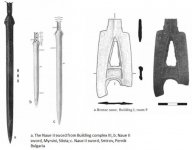Salento
Regular Member
- Messages
- 5,635
- Reaction score
- 2,838
- Points
- 113
- Ethnic group
- Italian
- Y-DNA haplogroup
- T1a2 - SK1480
- mtDNA haplogroup
- H12a
yes, p.285-286
Utilizzando Tapatalk
I give a hint:
.... Many of the objects found, could have been sold to the Mycenaeans in Italy. (maybe)
Weapons however is a different story.
It’s highly probable to assume that were brought by Italian Warriors (some of the weapons were also built on site probably by them)...




